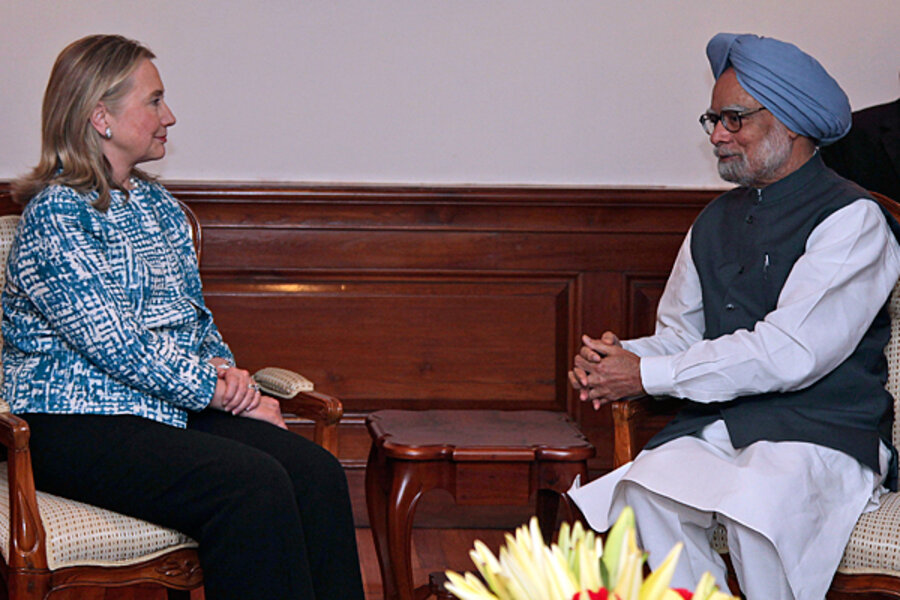Clinton in India: a gentle reminder about all that Iranian oil
Loading...
American Secretary of State Hillary Clinton’s trip to India this week is a gentle reminder that the US would like its closest ally in Asia to be a little less friendly with Iran.
India currently imports almost 80 percent of its oil, and some 11 percent of the total comes from Iran, in order to help fuel its solidly booming economy. That growth itself is welcomed by Washington, but a recently passed US law would impose sanctions on countries, like India, who purchase their oil from Iran, starting June 28. The US fears that Iran may be moving toward developing nuclear weapons, a charge that Iran denies.
"We believe, at this moment in time, the principal threat is a nuclear-armed Iran," said Ms. Clinton, during an interaction with reporters in the eastern city of Kolkata. "We need India to be part of the international effort.... We hope they will do even more and we think there is an adequate supply in the market place as Saudi Arabia, Iraq. We think this is part of India's role in the international community."
Few expect India to turn off the spigots right away. Replacing $11 billion worth of Iranian oil each year isn’t easy. But for a variety of other reasons, including internal politics, some analysts say that India will be either unwilling or unable to deliver on Clinton’s request.
“It’s entirely reasonable to request this, but the question is; will they be able to pull it off?” says Sumit Ganguly, a professor of political science and Rabindranath Tagore Chair of Indian Cultures and Civilizations at Indiana University. “It comes down to coalition politics and a small number of people who still want to unfurl the banner of non-alignment.”
Matters are not made easier by the fact that the current government of India is a coalition propped up by smaller left-wing parties, adds Mr. Ganguly, none of whom are particularly fond of the United States or its push for open and free markets.
“India thus far has failed to come up with an answer to the question of what they want from the US, and what kind of relationship they want to have with the United States,” says Ganguly. “I fear that some people in the US are starting to ask, is this really worth it.”
If America and India didn’t have so many interests in common, this might be considered to be a spat.
Both countries are nuclear-weapons states that are committed to preventing nuclear weapons from proliferating. Both countries seek lower trade barriers in general, and both countries want India to rise up as a regional economic power, as a counterbalance to the Asian giant, China. Both countries, too, favor stable democratic governance, and both see the rise of militant Islam – particularly from uncontrolled areas of Pakistan – as a threat.
Gone are the bad old days when post-colonial Indian governments viewed every action by Washington as an attack on its sovereignty, or when Washington viewed New Delhi as a pawn of the Soviet Union. Now, when Washington talks about India, it tends to coo.
Typical is this statement by Robert Blake, assistant secretary of state for South and Central Asia, in a speech last May.
“India is a rising giant whose influence is being felt not only in the Indian Ocean, but clear across Asia Pacific to the shores of the Americas, in Africa, the Middle East, and in Central Asia,” said Mr. Blake. “Its rise – fueled by a young, optimistic, dynamic, educated population – may well be the biggest story of the 21st century.”
Even when it comes to Iranian oil, India and the US don’t need to agree to disagree. India simply hasn’t made up its mind, and some question whether India even has the option to consider a cutoff.
A 56-member delegation of the Iranian Chamber of Commerce is also present in New Delhi to remind the Indian government that, as the chairman of the Iranian delegation said, “you need oil and we need to sell.”
Again, in worse times, America might see this as Indian two-faced diplomacy. But the overall state of US-Indian relations is positive. The question is whether Clinton has the kind of leverage to get India to do more than what it is already willing to do, which in the case of Iranian oil, isn’t much.
Get daily or weekly updates from CSMonitor.com delivered to your inbox. Sign up today.







